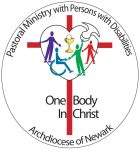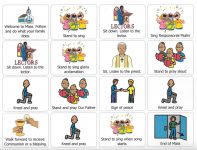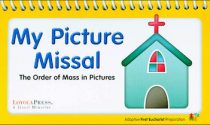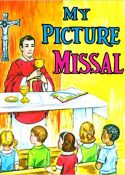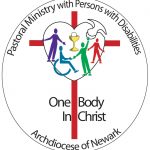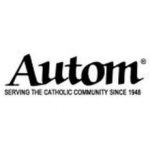
Home > Offices > Office for Persons with Disabilities > Media & MONTHLY NEWSLETTER > Sensory-Friendly Mass
Sensory-Friendly Mass
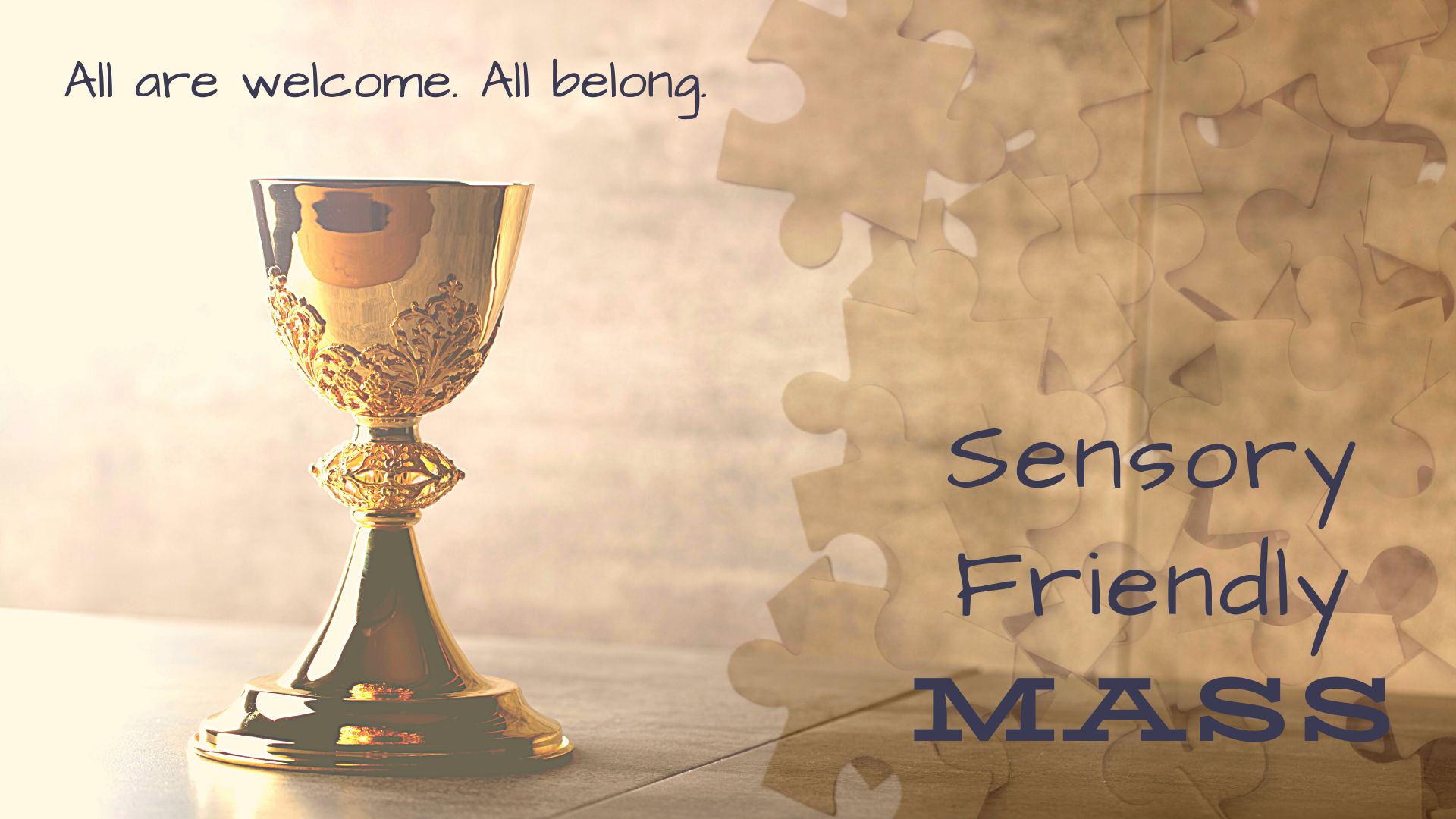
In an effort to embrace and welcome the members of our church with Autism, Down Syndrome, and other intellectual and developmental disabilities, the Archdiocese of Cincinnati has begun hosting Sensory-Friendly Liturgies. These Masses include lower lights, softer music, scripture from the Children’s Lectionary, and shorter more literal homilies; however, the biggest difference is that we try to create an environment free of stigma. We encourage families and individuals to get up and move if needed, to bring alternative seating, fidgets or noise cancelling headphones, and to participate in the liturgy just as they are.
Learn More...
FREQUENTLY ASKED QUESTIONS
IN THE MEDIA
-
The Catholic Telegraph
-
The Catholic Register
-
The Catholic Telegraph- Being Pro Life Series
-
Missionary Thought- Amy O’Connell’s Blog
How to host a Sensory-Friendly Mass
In order to host a Sensory-Friendly Mass, there are two steps: Awareness & Accommodation.
AWARENESS
This first step is essential to help the average person in the pew understand the struggle of persons with disabilities. We have put together a number of RESOURCES that will assist you in creating awareness through:
- Bulletin Inserts & Announcements
- Sample Pulpit Announcements
- A brochure for parishioners (especially liturgical ministers)
- Videos of various lengths to raise awareness and start conversations
- References for a better understanding of persons with disabilities for Homilies
If the parishioners can understand the need for a Sensory-Friendly Mass and what that Mass will look like, they are more likely to support it. We recommend spending at least a month (every parish will be different) focusing on awareness and understanding before hosting a Sensory-Friendly Mass.
ACCOMMODATION
The second step is simple- prepare and host the liturgy. We realize that not every parish is going to be able to meet all of the criteria for an ideal Sensory-Friendly Mass. The most important aspect of the liturgy for persons with sensory issues is to be welcoming and inviting. Advertise for the Mass and extend an invitation to persons with autism, intellectual and developmental disabilities, or even persons with Alzheimer’s Disease or dementia in your area. A Sensory-Friendly Mass requires a few small adjustments, but they are not tedious or burdensome. Check out our RESOURCES section for more information on appropriate accommodations, homily helps to make your homily more literal, and a toolkit of adaptive materials for families.
Resources for Parishes
Homily Helps & Suggestions
Persons with autism and intellectual and developmental disabilities understand content in a more literal way. For each week of our liturgical cycle, we have provided a few very basic suggestions for how to tailor your homily to make it more literal for many of the people who would choose to attend a Sensory-Friendly Mass and also for families with children. These suggestions are just a jumping off point and personal stories, visual aids, and interactive questions could be a great way to build an effective Homily that meets the needs of a neurodiverse community. At the top of each week, there is a link to a digital and printable Children’s Lectionary provided by Pflaum. Another great resource for developmentally appropriate reflections on the weekly readings can be found on the Loyola Press Website.
Homily Suggestions: (Visual aid: show an enlarged photo or art of someone worrying) What makes you worry? Tell a story about worrying. Jesus tells us not to worry, but to pray and follow him. What does it look like to follow Jesus? What does it look like to pray? Prayer is just talking to God like you would to your parents or a friend. You can pray when you are worried and ask God for help. If we pray and follow Jesus, we will live forever in heaven.
Homily Suggestions: John the Baptist was Jesus’ cousin. He was a helper. John the Baptist was a little bit older than Jesus, and he began to preach to people to prepare them for when Jesus came. John wore animal fur and lived outside or in caves. He ate locusts which are a type of bug. He told people to “repent” or ask God for forgiveness for their sins. (Give a personal example of repentance.) During Advent, we are waiting to celebrate Jesus’ birth. What can you do to be prepared for Jesus’ birthday?
Homily Suggestions: John the Baptist was Jesus’ cousin. He came before Jesus to help people prepare their hearts for God. In today’s readings, we learn about how we can follow God in our lives. We should share, treat one another with kindness, be thankful, and pray often. Which of these things (sharing, treat one another with kindness, be thankful, and pray often) do you need to improve? What can you do to better follow God.
Today is a special day of celebration during Advent. Today we focus on JOY. What is joy? Joy is happiness that we feel with God. Some things might make us feel happy: our favorite toys, food that we enjoy, music; but JOY is different. JOY is when we experience God’s grace. This can make us feel happy or peaceful, but it is a gift from God. (Give an example of a time when you felt happy and a time that you felt JOY) Today we think about the JOY of Christmas that is about to come. We think about the JOY of God’s greatest gift to us, the gift of Jesus’ birth. Jesus’ birth is more than a present that might make us happy for a little while, Jesus is a gift that can make us JOYFUL forever.
Homily Suggestions: (Visual Aid: show a large image of the Visitation; point to the people in the photo for a frame of reference) Today we hear the story of Mary’s visit to see her cousin Elizabeth. Do you ever go to visit your family? Do you have to travel for a long time or a short time? Mary traveled for a long time to visit her cousin. When she went to visit Elizabeth, she was pregnant with Jesus and Elizabeth was pregnant too. Elizabeth was pregnant with John the Baptist. Even before Jesus and John were born, John jumped in his mother’s womb for JOY when he was near his cousin Jesus. He was so excited to meet the Christ child. When Elizabeth feels her baby jump for JOY, she says, “Blessed are you among women and blessed is the fruit of your womb!” Where else do we hear those words? The first part of the Hail Mary comes straight from the Bible. In the second part, we ask Mary to pray for us so that we can be more like her son, Jesus. Let’s pray the Hail Mary together. This week, as we get ready for Christmas, try to pray the Hail Mary every day and remember the JOY that John and Elizabeth felt when they knew that the savior was coming.
Homily Suggestions: (Visual Aid: Show an image of the Holy Family) In today’s readings, we hear that we are to “Honor our father and mother.” How do we honor our father and mother? We also hear more about Jesus’ earthly father, Joseph. God told Joseph to take Jesus and Mary and flee from Bethlehem. Their lives were in danger and Jesus, Mary and Joseph escaped and were safe. Joseph listened to God, our father in heaven, and God protected them all from harm. As Jesus grew up, he followed the same commandment to “honor our father and mother.” He always honored them and listened to them. When we follow God’s commandments, we are also honoring our Father in Heaven, God. How can you be like Joseph and Jesus and honor your father and mother?
Homily Suggestions: (Visual Aid: Bring the Nativity Scene into the church and show the wisemen) Today we hear the story of the “three wisemen” who visited Jesus after he was born. The wisemen are very important. These wisemen already knew that Jesus was the Messiah, the savior of the world. They brought Jesus gifts and worshiped him when he was born. On Christmas, we give gifts to one another to remember the gifts that these wisemen brought to Jesus. Did you get gifts for Christmas? What was your favorite gift? Jesus is God’s greatest gift to us, and just like the wisemen, we can give Jesus gifts as well. How do we give Jesus gifts? We give Jesus gifts when we show love to others or when we take time to give thanks and praise.
Homily Suggestions: (Visual Aid: Show an image of the Baptism of Jesus by John) Do any of you remember your Baptism? Today we celebrate the Baptism of Jesus! Most of you were baptized as children, but Jesus was baptized as an adult. Jesus’ cousin’s name was John the Baptist. He was just a little older than Jesus, but he began to preach before Jesus started his ministry. John the Baptist got his name because he called people to repent and be baptized. Jesus came to be baptized by John and something very special happened. When Jesus was baptized, the Holy Spirit came down upon him in the form of a dove and the voice of God came from the heavens saying, “You are my beloved Son; with you I am well pleased.” As disciples of Jesus, we are all baptized for the forgiveness of sins and we receive the gift of the Holy Spirit to help us to follow Jesus.
Homily Suggestions: (Visual Aid: Have a stack of letters) Focusing on 2nd Reading: Our second reading today is a letter from St. Paul. St. Paul wrote many letters to his friends in Christ. He traveled around and taught people about Jesus and how to be a disciple. Then when he moved on to the next place, he wrote letters to his friends to help inspire them to continue to follow Jesus even when it was hard to make the right decision. In the letter that we read today, St. Paul talks about the many gifts that we all receive from God through the Holy Spirit. God has given each of us special gifts that we are meant to share with one another. (Provide an example of someone using their gifts). What gifts do you have that you can share with others?
Focusing on Gospel: (Visual Aid: Have a jug of water available) In today’s Gospel Reading, Jesus performs his first miracle. A miracle is something that might seem impossible but through God is made real. Jesus went to a wedding with his mother. Have you ever gone to a wedding? There is usually a big party afterwards called a reception where everyone celebrates the newly married bride and groom. At this wedding, there were so many people at the reception that they ran out of wine for the people to drink. Back in Jesus’ time, there were not a lot of choices for people to drink, so to run out of wine was a BIG DEAL. Jesus took jugs of water and blessed them and the water became wine, and not just any wine, but the very best wine. Jesus can do the same for us. If we ask Jesus for his help, he can help us to become even better than what we ever expected. (Share a personal story about being transformed by Jesus).
Homily Suggestions: (Visual Aid: Show tablets with the 10 Commandments on them) In today’s readings we learn about the importance of “the Word of God.” The people in the first reading listen to Ezra read from the Book of the Law, which was written by Moses for the people. Later in the Gospel, we hear Jesus read from the book of Isaiah, just like we hear people read during Mass. Isaiah wrote this book about 700 years before Jesus was born, but in this book he talks all about Jesus. God shared with Isaiah that a savior would one day be born who would rescue the people of Israel. In the Gospel, Jesus reads, “The Lord’s Spirit has come to me, because he has chosen me to tell the good news to the poor. The Lord has sent me to announce freedom for prisoners, to give sight to the blind, to free everyone who suffers, and to say, ‘This is the year the Lord has chosen.’” Then Jesus tells everyone that these words have come true through him. Jesus came to free the imprisoned, to give sight to the blind and to heal all who suffer. He was the person who Isaiah wrote about.
Homily Suggestions: (Visual Aid: Have several images of people living a life of love and not living a life of love, use these to ask which are an example of loving like Jesus) Focusing on the 2nd Reading: Do any of us know what God looks like? God is a mystery. He is beyond our understanding, but we do know one thing about God. Jesus tells us that God is love. Our second reading today tells us what love looks like. Love is not a feeling like we often see on television or in movies. Love is something that we do even when we don’t feel like it. “Love is kind and patient, never jealous, boastful, proud, or rude. Love isn’t selfish or quick tempered. It doesn’t keep a record of wrongs that others do. Love rejoices in the truth, but not in evil. Love is always supportive, loyal, hopeful, and trusting. Love never fails!“ (Give an example of perfect love.) This week, take time to think about how you can be more like God. How can you show love to your family and friends?
Homily Suggestions: (Visual Aid: Use a fishing net or an enlarged image of this miracle as depicted in art) In today’s Gospel Reading, we get to see another miracle. After speaking to a great crowd of people, Jesus, gets into a boat and goes out to sea with some of his disciples. He tells them to let down their nets to catch some fish, but Peter tells Jesus that they already spent the whole day fishing and caught nothing. Peter doubted Jesus, but he still did what Jesus commanded and let down his nets. When they raised the nets, there were so many fish that they filled two boats. Sometimes we might doubt God. We might not think that God is powerful enough to do something, but if we have faith, God can do anything. (Give an example of trusting in God.)
Homily Suggestions: (Visual Aid: Have an enlarged image of each of the Beatitudes to reference while you speak) In today’s Gospel Reading, Jesus gives us the Beatitudes. We learn that the people who seem to be the least important on earth will get the greatest rewards in heaven. People who are hurting or sad will rejoice. People who show mercy and kindness will find their reward. We are called to focus on the good that will come from suffering, not on the suffering itself. (Give an example of a time when you focused too much on the suffering and not enough on faith.) Is there anything that you suffer with right now? What can you focus on instead of the suffering?
Homily Suggestions: In today’s readings we learn about what it means to love the way that God calls us to love. Remember, love is not a feeling that we get when we like someone. Love is an action. It means that we always make the right choice towards others. Jesus tells us that we should give without expecting anything back. What do you think about that? How would you feel if you gave someone a present, but they didn’t give you one in return? Real love means that you give to others, but don’t expect anything in return. Jesus also tells us that we should love our enemies. Do you have anyone that you do not like? Did you know that you are supposed to love those people even more? (Give a personal example of selfless love.) How can you show love to everyone you meet?
Homily Suggestions: (Visual Aid: Show different types of plants and ask about what type of fruits are produced by each. Talk about their differences.) In today’s first reading we hear, “You know what a tree is like by its fruit. You know what people are like by their words.” Your words are like fruit of your character. What is character? Character is who you are on the inside. What would be an example of someone who has good character? (Give examples of fruit that comes from both good and bad characters.) We are like plants who produce fruit. Our fruit is our words and our actions. Jesus says, “A good tree cannot produce bad fruit, and a bad tree cannot produce good fruit. You can tell what a tree is like by the fruit it produces.” What kind of plant would you like to be- a tree that bears good fruit or a tree that bears bad fruit?
- Sensory Friendly Mass
| Title | Description | Date added | Download |
|---|---|---|---|
| Church Guide for Parents (A Social Story) | 11-25-2020 | DownloadPreview | |
| Going to Mass Sensory Book | 11-25-2020 | DownloadPreview | |
| Letter to Pastors | 11-25-2020 | DownloadPreview | |
| Sample Bulletin & Pulpit Announcements | 11-25-2020 | DownloadPreview | |
| Sensory-Friendly Mass Checklist | 12-10-2021 | Download | |
| Week 1- Autism Awareness | 11-25-2020 | DownloadPreview | |
| Week 2- Developmental Disabilities Awareness | 11-25-2020 | DownloadPreview | |
| Week 3- Mental Health Awareness | 11-25-2020 | DownloadPreview | |
| Welcoming Persons with Sensory Needs | 11-25-2020 | DownloadPreview |
Toolkit for Families
This free printable resource, created by the Archdiocese of Newark, offers a concrete explanation of the liturgy with picture icons to indicate when to sit, stand, or kneel. This missal also includes all of the prayers and responses.
This free printable resource, created by the Archdiocese of Cincinnati, offers simple language and concrete explanations of the liturgy with picture illustrations. It also discusses expectations for behavior during different parts of the Mass.
This free printable resource, created by the Archdiocese of Cincinnati, offers simple language and picture illustrations. This is an incredibly convenient resource that includes the essential parts of the Mass on a single page.
These picture oriented flip books, created by Loyola Press, walk children through the parts of the Mass and provides interactive cues for actions and gestures. They are available for purchase and also offered in SPANISH.
The St. Joseph Picture Books Series is intended to help teach the basics of the Catholic Faith to children in an enjoyable manner. My Picture Missal is a simple introduction to the Mass for children. It is illustrated in full color and available for purchase.
For parishes preparing for Sensory-Friendly Liturgies, a Children’s Lectionary can offer a more literal interpretation of the Sunday readings.
Pflaum Publishing Group offers a downloadable copy of the First Reading, Responsorial Psalm, and Gospel for Children’s Liturgy of the Word in both English and Spanish. All you need is to log in with your email address and access is free. The books are also available for purchase.
Approved for use in the Dioceses of the United States of America by the National Conference of Catholic Bishops, confirmed by the Apostolic See, and prepared by the Committee on the Liturgy, National Conference of Catholic Bishops, the Lectionary for Masses with Children is a liturgical book containing readings for Masses with children on Sundays and weekdays.
Social Stories are an important way to prepare persons with intellectual and developmental disabilities for events or occurances. It is important to explain the purpose, what will take place, and articulate clear expectation. Below are some great Social Stories that are printable for reuse.
This Social Story, created by the Archdiocese of Indianapolis, discusses the COVID Pandemic, the changes that people might see at church to keep us safe, and what Mass will be like when we return.
This Social Story, created by the Archdiocese of Newark, tells the story of going to Mass in simple language with accompanying photos.
This Social Story, created by the Archdiocese of Cincinnati, is a single page that discusses why we go to Mass, who goes to Mass, what we see at Mass, and expected behaviors.
This Social Story, created by Creative Learning 4 Kidz, is downloadable for purchase. It addresses things you might do at Mass and how to behave during Mass. This book also comes with a set of 12 Picture Icons. These are a great visual aid for children.
Manipulatives are tactile items that can be used as a tangible focus. Below is a list of some Catholic learning manipulatives that are interactive yet still focus on the faith.
A set of five plush manipulatives, each depicting an item from Catholic liturgy or devotion. Toys are illustrated on both sides. Set includes monstrance, host, chalice, Lectionary/Roman Missal, and rosary. Items match illustrations from Plush Mass Book, also for sale.
Children’s Mass Kit: Children will learn, celebrate, and remember how Jesus celebrated the first Mass at the Last Supper with this colorful pop-out Mass kit.
My Little Church Magnet Playset: My Little Church features fully illustrated magnets that can be arranged on the trifold magnet book. An engaging activity that forms little hearts and minds in the Catholic faith.
My Pop-Out Mass Activity Set: Unfold, assemble and learn by interacting with the pieces on the Mass table. Colorful pieces include the chalice, Eucharist Bread, incense jar, pillar candles to name a few.
My Mass Kit: 12-piece set includes plush replicas of items used by the celebrant: Crucifix, Chalice, Thurible, Finger Bowl, 2 Cruets, 2 Candles, Paten (cotton/ polyester blend), Corporal & Purificator (cotton cloth) and play Hosts (foam). This child version of the celebration of Mass comes complete with a colorful 24-page illustrated spiral booklet and carrying case with shoulder strap and name tag.
Silicon Rosaries: Cotton string and food-grade silicone are used to create a rosary that is strong and durable – the perfect combination for a rosary that your child will want to take with them everywhere they go.
The Mass Window Chart: The Mass Window Chart helps children grow in their Catholic faith as they move through easy-to-read charts, closing each window as they learn.
Forgiveness Board: This Forgiveness Board helps children learn to ask for forgiveness and to give forgiveness. This wipe-off board allows kids to actively work on forgiveness. Includes dry-erase pen.
Chews Life is a mama owned and run business that creates beautiful, practical rosaries and other devotional aids that foster a love for Our Lord and His Mother. It is our mission to equip all Catholics with rosaries for life because we believe that a community of faithful Catholics united in praying the Rosary will change the world!
Shining Light Dolls’ award-winning Catholic books, toys and more are the fun and easy way to grow a strong, lifelong relationship with Jesus and His Saints. There are plush items as well as smaller vinyl saint dolls that are nearly unbreakable.
Engage children in the Mass and inspire them to love the Holy Eucharist. Beautiful artwork and hands-on activities like wheels, flaps, and tracing invite children into the beauty of the Mass. Simple explanations and prayers of the Mass provide a deeper understanding for little ones.
SENSORY FRIENDLY MASSES:
St. Maximilian Kolbe-Liberty Twp. Sundays at 11:00 AM
St. Ignatius of Loyola- Cincinnati Sundays at 6:30 AM
St. Christopher-Vandalia 3rd Saturday each month at 5:00 PM
St. John Fisher-Newtown 1st Sunday of the Month 12:30

